Every July Mongolia’s steppes come alive as the Naadam Festival celebrates nomadic sports that date back to the days of Genghis Khan. It’s an exciting time to visit a country far off the beaten path. Outside Ulaanbaatar—its modern capital buzzing with copper, gold, and coal mining wealth and a new Shangri-La hotel—encounter an adventure-rich land of camel-trod deserts and vast grasslands lorded over by craggy mountains.
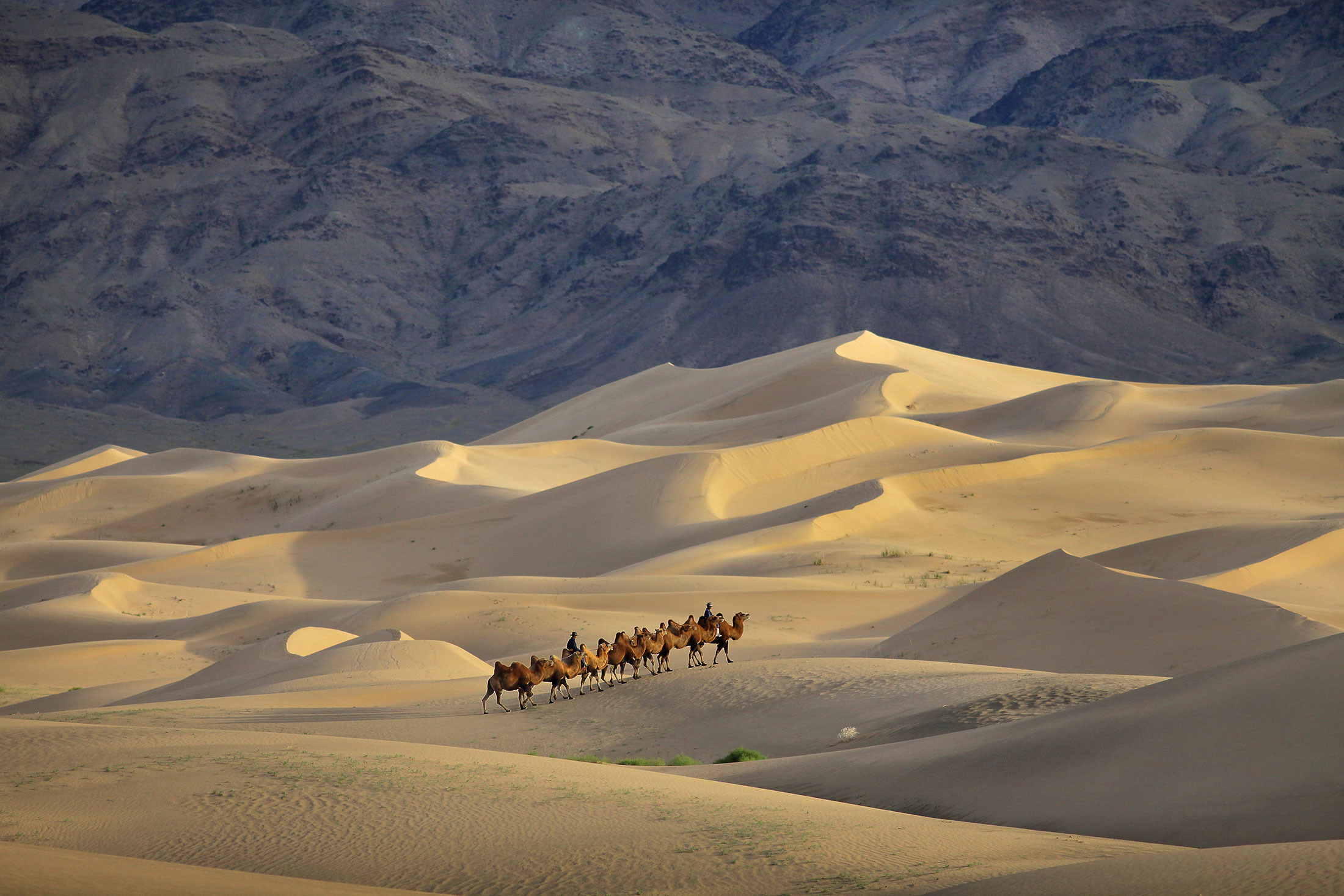
Camels in Gobi Dessert
Animals in Mongolia's Great Gobi National Park include some of the few remaining two-humped Bactrian camels in the wild, the last surviving Gobi bears (at last count there are only 50), and Snow Leopards (a quarter of the world's population are found in Mongolia). The Gobi is also a major source of important fossil discoveries, including the first dinosaur eggs found by Roy Chapman Andrews, who explored its great expanse for New York’s American Museum of Natural History from 1922 to 1930. His adventures are said to be the inspiration for Indiana Jones.
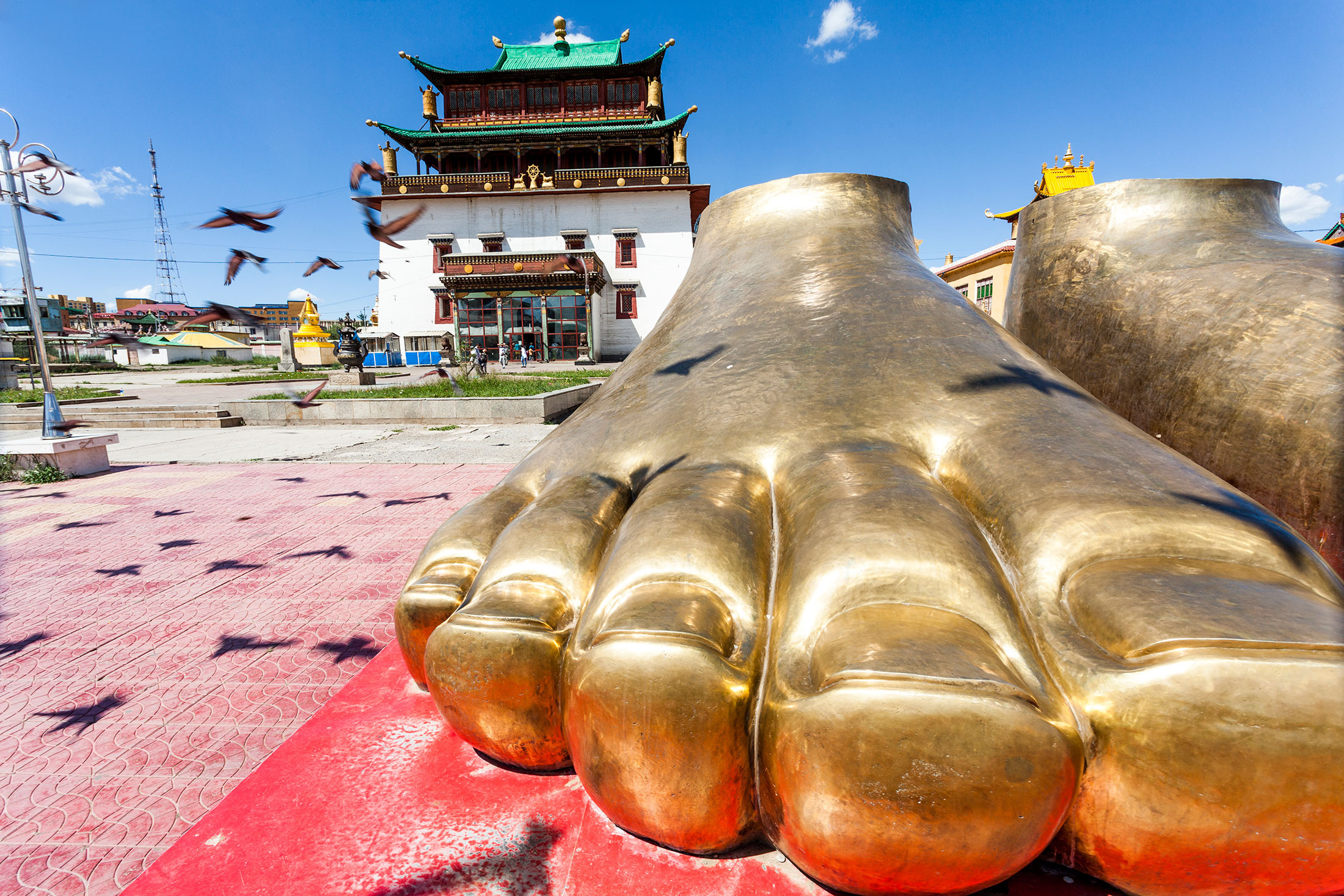
Gandan Khiid Monastery
Gandan Khiid Monastery (Gandantegchinlen), in the center of Mongolia's capital city Ulaanbaatar, escaped the destruction of monasteries during the Communist period in the 1930s. It was reopened in 1944 as a “show monastery” for foreign visitors, with some of the buildings used as cow sheds, and was not fully functioning for religious purposes until the 1990s when Buddhism was practiced openly again. In this respect, it's one of the country’s most important monasteries. Visit early, around 9 a.m., to witness the morning ceremony. Inside the main temple is an 80-foot-high statue of Magjid Janraisig (the lord who looks in every direction), which is strewn with precious stones.
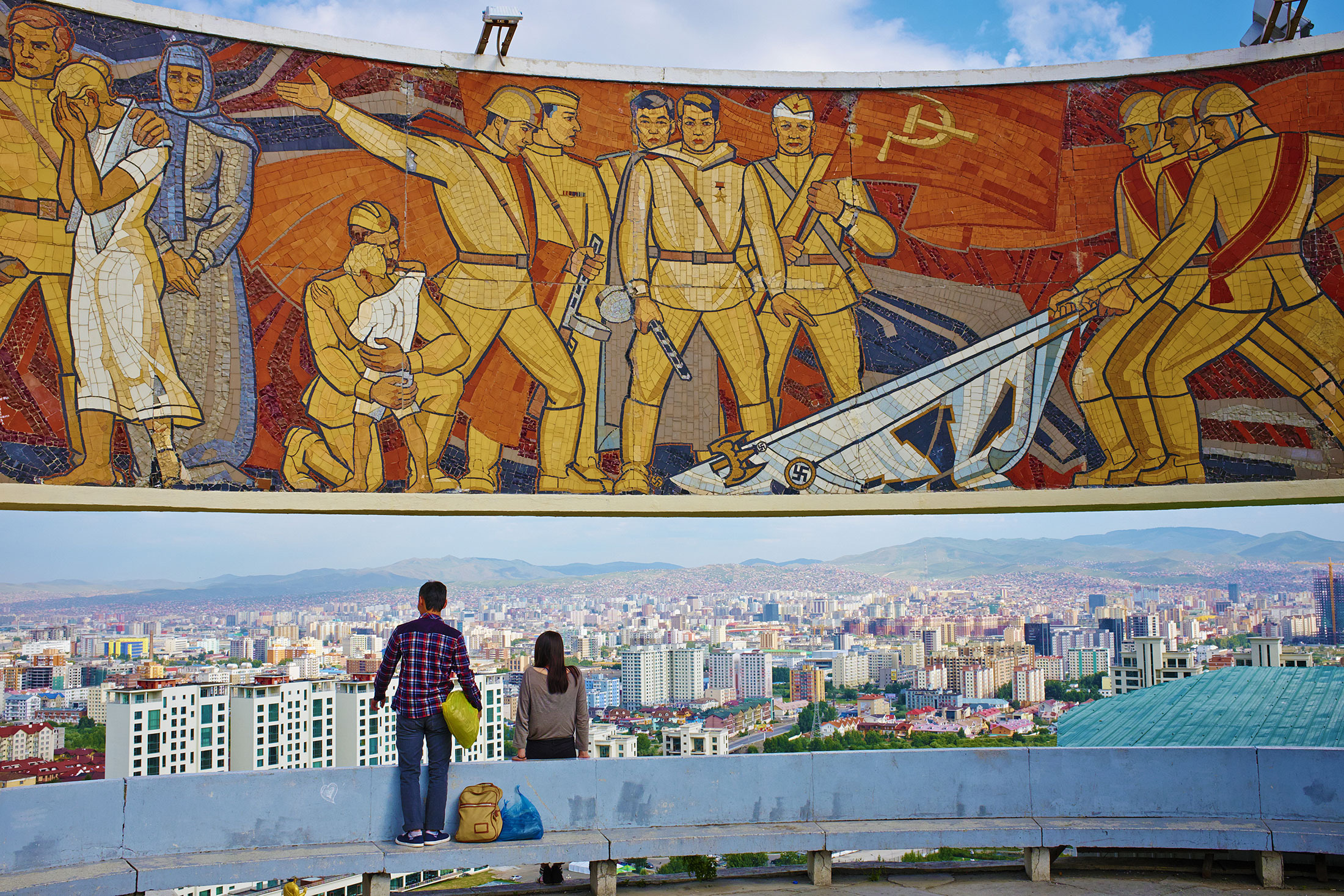
Zaisan Memorial
The circular Zaisan Memorial was erected on top of a hill in the south of Ulaanbataar by the former Soviet Union to commemorate those killed in the Second World War. The colorful mural is worth the climb, as is the view of the city on a clear day. At the foot of the hill there’s also a large Buddha statue and another memorial of a Soviet tank, which includes a map of its route from Moscow in 1943 to Berlin in 1945.

Kazakh Eagle Hunters
It’s highly unusual to find a girl hunting with a golden eagle, yet photographer Asher Svidensky discovered the then 13-year-old Ashol-Pan doing just that. The Kazakhs of the Altai Mountains have been hunting this way in western Mongolia for thousands of years. Boys start hunting at a young age, building power in their little arms to hold the heavy bird, and learning not to fear but respect the birds of prey who they use to hunt hare and foxes. Mature golden eagles are set free to breed in the wild, with a butchered sheep to help them on their way.
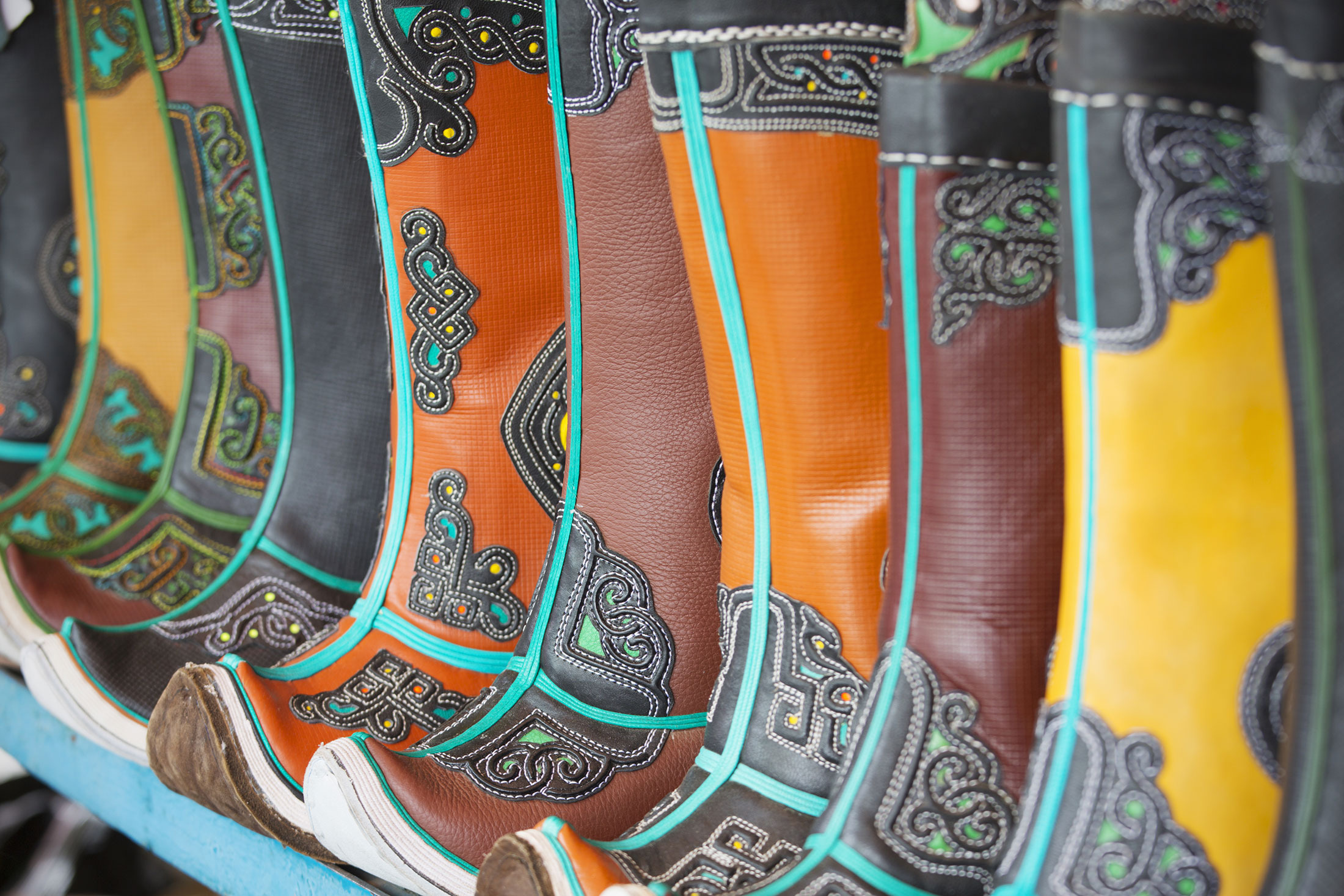
Mongolian Boots
Known as “Gutul,” hand-sewn traditional Mongolian boots have a pointed upturned toe to prevent horse riders from getting caught in stirrups if they fall. Here, some with applique designs are on sale at Ulaanbaatar’s Naran Tuul (black market) in the Bayanzurh District.
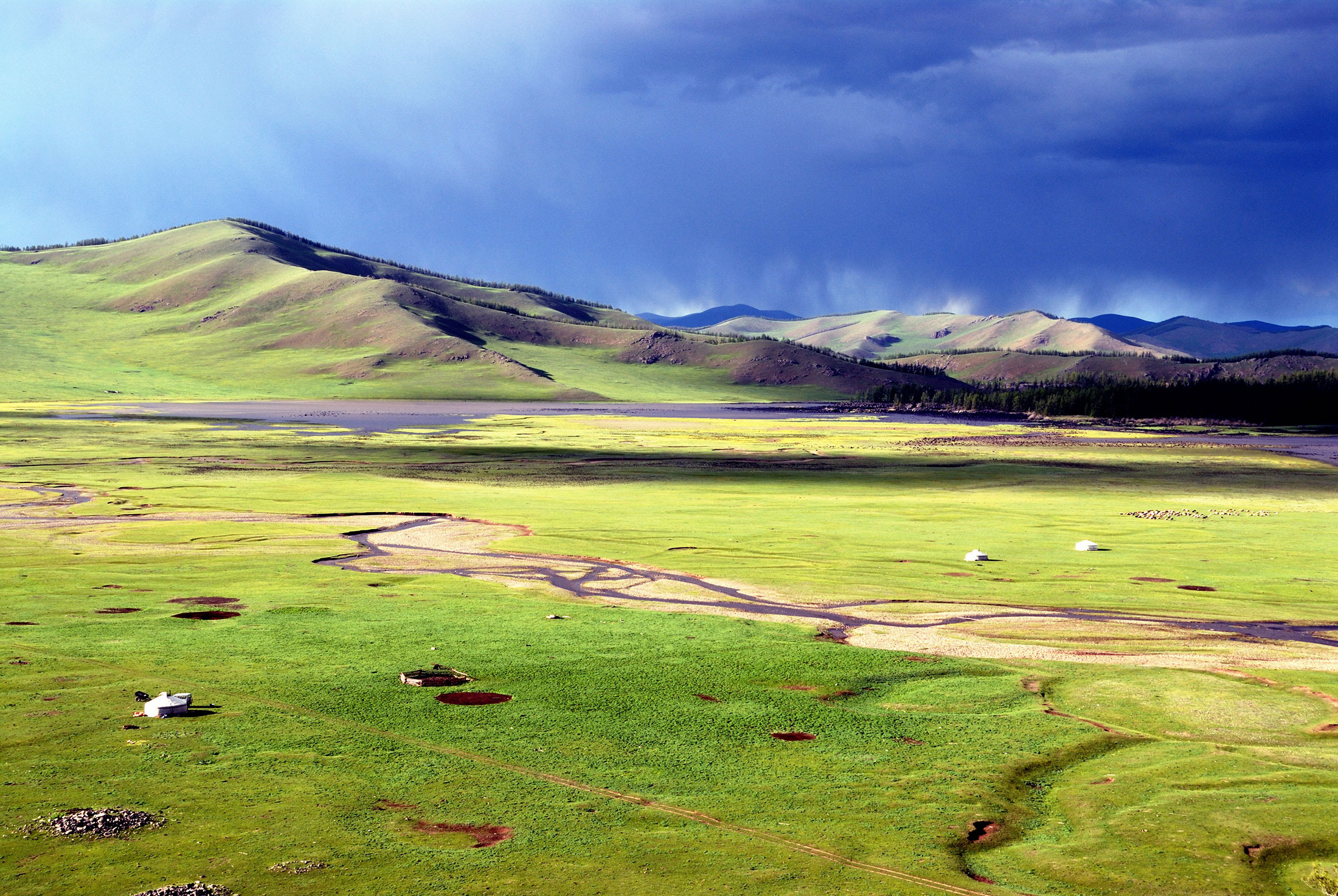
Khangai
Mongolia is a country blessed with a varied and stunning countryside, from rugged mountain ranges and sweeping steppes to ancient freshwater lakes and fossil-strewn desert. Here the Khangai mountain range rises from gentle slopes and pastureland. Its highest peak, Otgontenger, tops out at 13,200 feet.
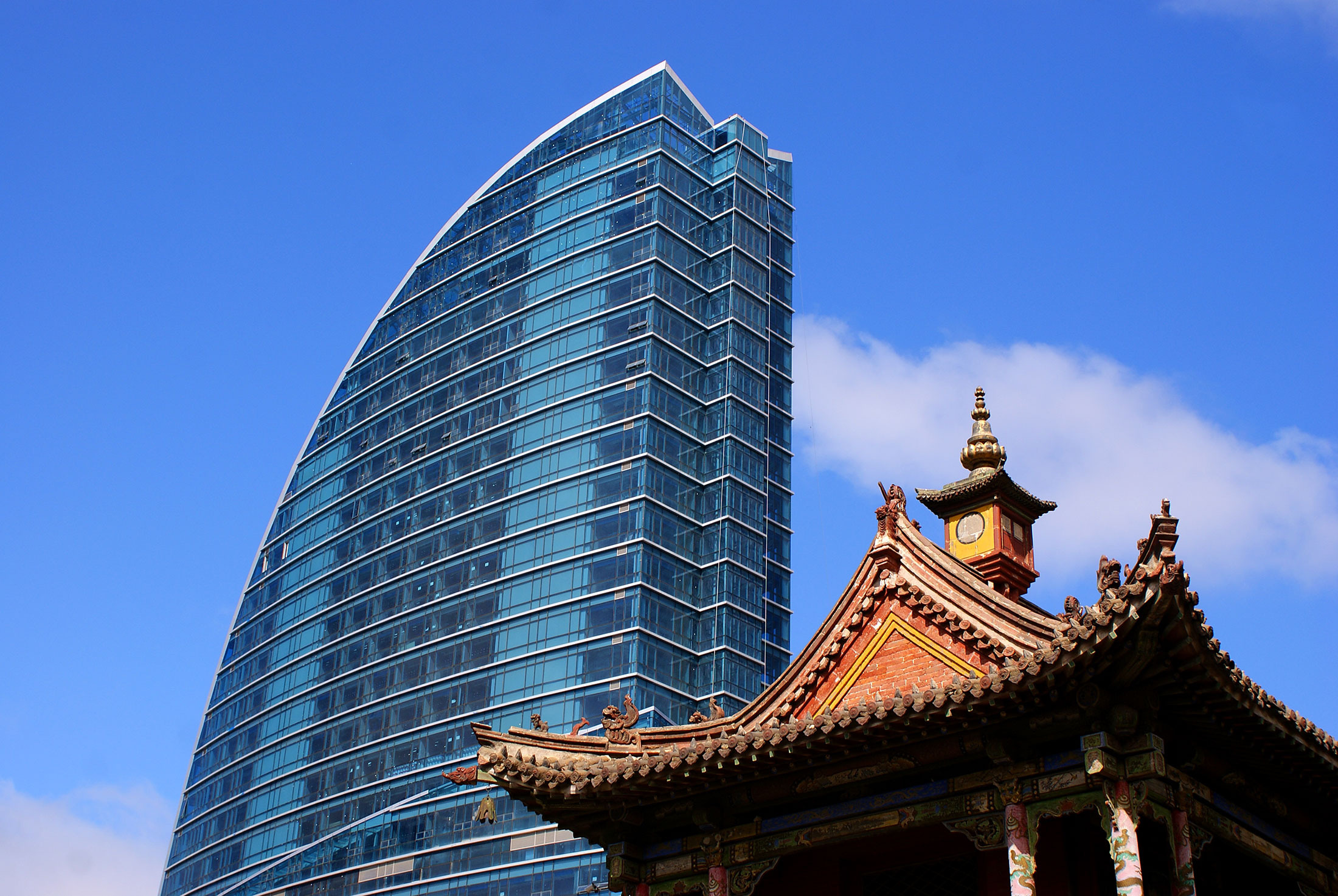
Ancient and Modern Ulaanbaatar
The roof of Choijin Lama temple, which the Communist regime transformed into a museum denouncing the "old ways," can be seen alongside the 25-story Blue Sky Tower in Ulaanbaatar, which was completed in 2010. Half of Mongolia’s population lives in or near the booming capital, where you’ll find a glitzy mall on Sukhbaatar Square and that undisputable sign of new wealth, a Louis Vuitton outlet. On June 3, a 290-room Shangri-La hotel (bloom.bg/1JtePlO) opened, helping to remedy the city’s scarce luxury accommodation (and a perfect antidote if you’ve been roughing it out on the steppe). Despite the modern center, the outskirts of the capital, a former nomadic city that changed location three times a year, is surrounded by traditional gers (Mongolian yurts).

Game of Kings
Horse Polo may be a game for the rich and the royal in other parts of the world, but in Mongolia where it’s been played for centuries—spread by the invading forces of Genghis Khan who used it to entertain and train his cavalry—it’s an altogether more egalitarian affair. Here, young polo players hone their skills in the Orkhon Valley Polo Camp.
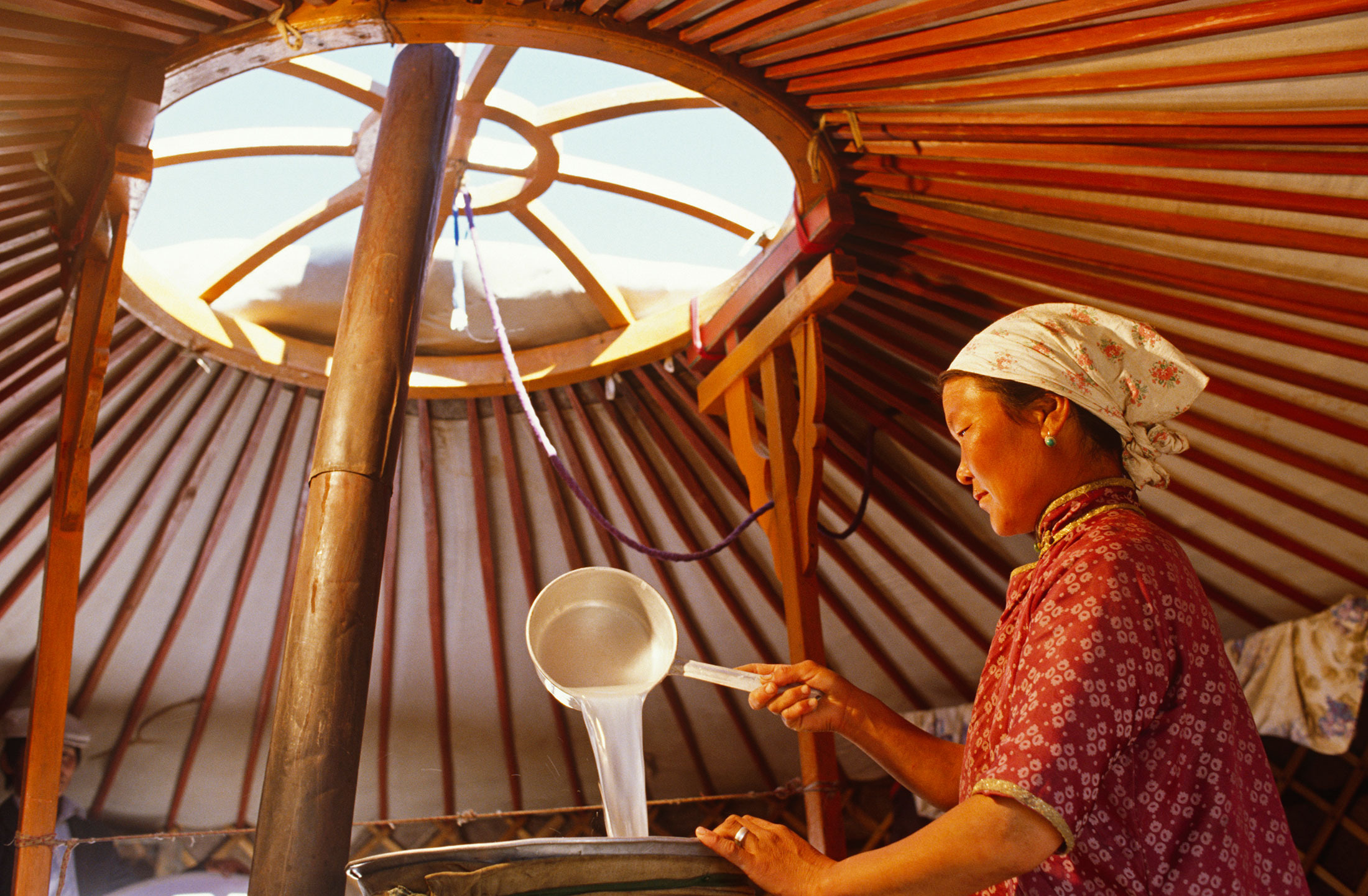
Arkhi
A woman prepares milk, which will be distilled to produce the potent spirit called arkhi. This sour and potent brew, with a 10 percent ABV, has been made since the 14th century from either fermented horse or yak’s milk. If you’re lucky enough to be invited into a family’s ger, chances are you’ll be offered a glass of arkhi. It’s consumed cold and (if you’re smart) in one go.

Wrestling at Naadam Festival
Wrestling, archery, and horse racing are the “three manly sports” celebrated during the summer’s Naadam Festival, a national holiday which runs for three days each July. The uniform of tight shorts, open jackets, and traditional Mongolian boots are topped off with small hats—it’s said that the open jackets are due to a woman once taking part and winning (although they're welcome to compete in archery and horse racing). There’s no weight division, so expect a lightweight wrestler trying his luck against a burly opponent. There’s also no time limit, so two well matched wrestlers can grapple for hours, giving you time to nip off for a khuurshuur (cold meat pancake). If any part of the body touches the ground (save the hands and, obviously, the feet), the match is over. The judges are then honored with an eagle dance called the devekh, which is also performed in honor of the defeated opponent. Win five rounds and you’re given the title of “Falcon,” win seven and you’re an “Elephant,” while the much celebrated overall winner is a “Lion.”

Lake Khuvsgul
Pristine Lake Khuvsgul, which sits at the foot of the Sayan Mountains in northwest Mongolia, bordering the great Siberian Taiga Forest, is one of Asia’s largest freshwater lakes (84 miles long by 24 miles wide). At over 2 million years old, it's also one of the world’s 17 ancient lakes and is nearly 900 feet deep, holding 70 percent of Mongolia’s fresh water. The province is teeming with wildlife and is home to some of the country’s oldest tribes, including the Tsaatan, or reindeer people, who have a lot in common with American Indians, continuing to live in deer hide tepees rather than gers (yurts).

Winter Place of Bogd KhanThis museum on the southern edge of Ulaanbaatar was originally built in 1893 as the Winter Palace of Mongolia’s eighth Living Buddha and last emperor. Inside you’ll discover his interest in all things animal; there’s a vast array of taxidermy, a robe made from 80 fox skins, and a yurt lined with snow leopard skins that’s uncomfortable viewing when you consider their current endangered status. But it’s not all furry stuff. The exhibits also include Mongolia’s 1911 Declaration of Independence from China, Buddhist art and sculpture, and the jewels worn by his pet elephant.
Source: www.bloomberg.com
Every July Mongolia’s steppes come alive as the Naadam Festival celebrates nomadic sports that date back to the days of Genghis Khan. It’s an exciting time to visit a country far off the beaten path. Outside Ulaanbaatar—its modern capital buzzing with copper, gold, and coal mining wealth and a new Shangri-La hotel—encounter an adventure-rich land of camel-trod deserts and vast grasslands lorded over by craggy mountains.

Camels in Gobi Dessert
Animals in Mongolia's Great Gobi National Park include some of the few remaining two-humped Bactrian camels in the wild, the last surviving Gobi bears (at last count there are only 50), and Snow Leopards (a quarter of the world's population are found in Mongolia). The Gobi is also a major source of important fossil discoveries, including the first dinosaur eggs found by Roy Chapman Andrews, who explored its great expanse for New York’s American Museum of Natural History from 1922 to 1930. His adventures are said to be the inspiration for Indiana Jones.

Gandan Khiid Monastery
Gandan Khiid Monastery (Gandantegchinlen), in the center of Mongolia's capital city Ulaanbaatar, escaped the destruction of monasteries during the Communist period in the 1930s. It was reopened in 1944 as a “show monastery” for foreign visitors, with some of the buildings used as cow sheds, and was not fully functioning for religious purposes until the 1990s when Buddhism was practiced openly again. In this respect, it's one of the country’s most important monasteries. Visit early, around 9 a.m., to witness the morning ceremony. Inside the main temple is an 80-foot-high statue of Magjid Janraisig (the lord who looks in every direction), which is strewn with precious stones.

Zaisan Memorial
The circular Zaisan Memorial was erected on top of a hill in the south of Ulaanbataar by the former Soviet Union to commemorate those killed in the Second World War. The colorful mural is worth the climb, as is the view of the city on a clear day. At the foot of the hill there’s also a large Buddha statue and another memorial of a Soviet tank, which includes a map of its route from Moscow in 1943 to Berlin in 1945.

Kazakh Eagle Hunters
It’s highly unusual to find a girl hunting with a golden eagle, yet photographer Asher Svidensky discovered the then 13-year-old Ashol-Pan doing just that. The Kazakhs of the Altai Mountains have been hunting this way in western Mongolia for thousands of years. Boys start hunting at a young age, building power in their little arms to hold the heavy bird, and learning not to fear but respect the birds of prey who they use to hunt hare and foxes. Mature golden eagles are set free to breed in the wild, with a butchered sheep to help them on their way.

Mongolian Boots
Known as “Gutul,” hand-sewn traditional Mongolian boots have a pointed upturned toe to prevent horse riders from getting caught in stirrups if they fall. Here, some with applique designs are on sale at Ulaanbaatar’s Naran Tuul (black market) in the Bayanzurh District.

Khangai
Mongolia is a country blessed with a varied and stunning countryside, from rugged mountain ranges and sweeping steppes to ancient freshwater lakes and fossil-strewn desert. Here the Khangai mountain range rises from gentle slopes and pastureland. Its highest peak, Otgontenger, tops out at 13,200 feet.

Ancient and Modern Ulaanbaatar
The roof of Choijin Lama temple, which the Communist regime transformed into a museum denouncing the "old ways," can be seen alongside the 25-story Blue Sky Tower in Ulaanbaatar, which was completed in 2010. Half of Mongolia’s population lives in or near the booming capital, where you’ll find a glitzy mall on Sukhbaatar Square and that undisputable sign of new wealth, a Louis Vuitton outlet. On June 3, a 290-room Shangri-La hotel (bloom.bg/1JtePlO) opened, helping to remedy the city’s scarce luxury accommodation (and a perfect antidote if you’ve been roughing it out on the steppe). Despite the modern center, the outskirts of the capital, a former nomadic city that changed location three times a year, is surrounded by traditional gers (Mongolian yurts).

Game of Kings
Horse Polo may be a game for the rich and the royal in other parts of the world, but in Mongolia where it’s been played for centuries—spread by the invading forces of Genghis Khan who used it to entertain and train his cavalry—it’s an altogether more egalitarian affair. Here, young polo players hone their skills in the Orkhon Valley Polo Camp.

Arkhi
A woman prepares milk, which will be distilled to produce the potent spirit called arkhi. This sour and potent brew, with a 10 percent ABV, has been made since the 14th century from either fermented horse or yak’s milk. If you’re lucky enough to be invited into a family’s ger, chances are you’ll be offered a glass of arkhi. It’s consumed cold and (if you’re smart) in one go.

Wrestling at Naadam Festival
Wrestling, archery, and horse racing are the “three manly sports” celebrated during the summer’s Naadam Festival, a national holiday which runs for three days each July. The uniform of tight shorts, open jackets, and traditional Mongolian boots are topped off with small hats—it’s said that the open jackets are due to a woman once taking part and winning (although they're welcome to compete in archery and horse racing). There’s no weight division, so expect a lightweight wrestler trying his luck against a burly opponent. There’s also no time limit, so two well matched wrestlers can grapple for hours, giving you time to nip off for a khuurshuur (cold meat pancake). If any part of the body touches the ground (save the hands and, obviously, the feet), the match is over. The judges are then honored with an eagle dance called the devekh, which is also performed in honor of the defeated opponent. Win five rounds and you’re given the title of “Falcon,” win seven and you’re an “Elephant,” while the much celebrated overall winner is a “Lion.”

Lake Khuvsgul
Pristine Lake Khuvsgul, which sits at the foot of the Sayan Mountains in northwest Mongolia, bordering the great Siberian Taiga Forest, is one of Asia’s largest freshwater lakes (84 miles long by 24 miles wide). At over 2 million years old, it's also one of the world’s 17 ancient lakes and is nearly 900 feet deep, holding 70 percent of Mongolia’s fresh water. The province is teeming with wildlife and is home to some of the country’s oldest tribes, including the Tsaatan, or reindeer people, who have a lot in common with American Indians, continuing to live in deer hide tepees rather than gers (yurts).

Winter Place of Bogd KhanThis museum on the southern edge of Ulaanbaatar was originally built in 1893 as the Winter Palace of Mongolia’s eighth Living Buddha and last emperor. Inside you’ll discover his interest in all things animal; there’s a vast array of taxidermy, a robe made from 80 fox skins, and a yurt lined with snow leopard skins that’s uncomfortable viewing when you consider their current endangered status. But it’s not all furry stuff. The exhibits also include Mongolia’s 1911 Declaration of Independence from China, Buddhist art and sculpture, and the jewels worn by his pet elephant.
Source: www.bloomberg.com
